Before the signing of MOU on May 15, a Colloquium was held with Central Saint Martins – University of the Arts London (CSM) on May 14.
Eleven faculty members from Tokyo Tech (Prof. Kayoko Nohara, Prof. Junichi Takada, Prof. Yoshiharu Tsukamoto, Prof. Masahiro Susa, Prof. Haruyuki Fujii, Prof. Daisuke Kurabayashi, Prof. Minoru Nakayama, Assoc. Prof. Naoya Abe, Assoc. Prof. Wataru Hijikata, and Hiroshi Tsuda(Executive officer of Concent, Inc.), and Susumu Yoneyama (URA)), four from CSM (Prof. Till, Ms. Dickson, and Project Professors of WRHI, Dr. (Reader) Betti Marenko and Dr. Ulrike Oberlack) gathered at the venue in South Bldg. 5. Heather Barnett and Dr. Nathan Cohen also joined from London via Skype. During the colloquium, in addition to launching the White Paper, Becoming Hybrid, which reflects the collaboration between the two universities in the past two and a half years and celebrated and celebrating the official MOU, the participants also joined a workshop utilizing LEGO to consider the methodology and meaning of Transdisciplinarity. Students from Nohara lab also assisted with the telecommunication, facilitation, and running of the event.
At the colloquium, faculty members from varying specialty gathered. It started with greeting and reflections on the previous activities by Dr. Marenko, Dr. Oberlack, and Prof. Nohara. The series of events and activities between the two universities started from a symposium in May 2017 and was followed by teaching and research residence of the CSM teaching faculties at Tokyo Tech, philosophy cafes, Wearable workshops, public workshop, and joint workshop held at CMS in London. With documentary films, the report showed the roadmap of the past explorations of the methodology and future visions of Transdisciplinarity. It had also gained grants from the Arts Council, Tokyo. This journey had been supported by diverse participants from educational institutions and corporations. Sharing the fruits of the experiments so far, Prof. Nohara also clarified that the final purpose of this project is not making products but raising questions and seeking solutions through the Transdisciplinarity when facing the uncertain future.
In the following session, Barnett via Skype facilitated a workshop utilizing LEGO as a tool. At the venue in Tokyo Tech, the participants were divided into three groups. First, every one produced their own LEGO works based on their own considerations of Hybrid Methodology, issues and visions about the future collaboration. At this stage, the works were abstract and carried out in silence. In the next part, the group members explained the meanings of their works inside the groups. Then it opened to the floor with the groups presenting their ideas and discussions. Dr. Cohen also joined from London and presented his LEGO work. The models were all unique, some taking metaphors from “flower”, “window”, and “human body”, some endowed with the meanings of “feasibility”, “diversity”, and “uncertainty”. The participants, using English or Japanese with the facility of simultaneous interpretation, and traveling between Tokyo and London, together delineated the unlimited potential and positive vision of Transdisciplinarity and Hybrid Methodology. Prof. Yoshiharu Tsukamoto from architectural studies employed “network” as the concept, joined LEGO bricks of different colors and the work became a large structure, which seemed to symbolize a “hybrid”. Hiroshi Tsuda presented one of which the bricks were added to each other not through the intended joining parts and revealed the expectation of the collaboration to question the conventional ways. He also presented the significance to explore once again the merger of varying disciplines before the process of modernization in the context of Japan.
In the final part, the participants expressed their visions of the future after the signing of MOU. Prof. Wataru Hijikata, who specializes in Mechanical Design and collaboration between medical studies and engineering (for example, artificial hearts) shared his opinion from the perspective of research in science and technology and presented the significance of the collaboration between science/technology and art/design, “science and technology is convenient in a way however it is art that entertain people. Only through the merger can we find the way leading to happiness.”
Staff and students from Nohara Lab also supported and participated in the colloquium. They also expressed the ideas about Transdisciplinarity and Hybrid after participating in the colloquium. Chihiro Wada (Doctoral first year) put down that “there is an attractive possibility the hybrid of art and science can bring to the world through influencing and complementing each other… I feel that art has rich resources or elements that science tends to lack or disregard such as “beauty” or “heart” or “kokoro” in Japanese. It is certainly impossible to enrich the world only by pursuing the technology or convenience. There are plenty of things that I can learn from the hybrid and I believe that it represents or indicates a lot about the depth or complexity of the world and also, human being.” Takumi Saito (Master’s first year) expressed his opinion that “the significance of hybridity emerges when each discipline faces problems that it cannot tackle with on its own.” The project also anticipates further exploration of the methods of Transdisciplinarity and Hybrid from the enthusiastic students and researchers.
With vibrant discussions, the colloquium crossed boundaries of language, academic disciplines, and physical space. The project members refreshed themselves after the MOU and would like to embrace further challenges with confidence and courage.
(by: Mengfei Pan)
Event Documentation
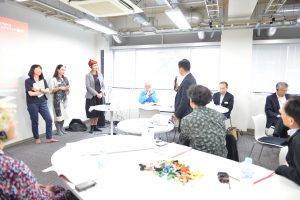
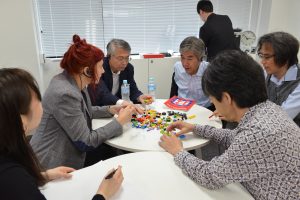
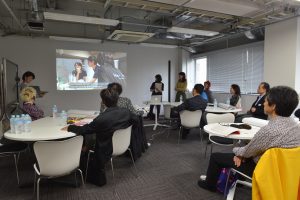
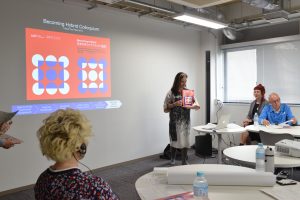
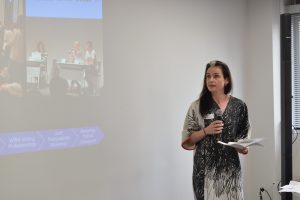
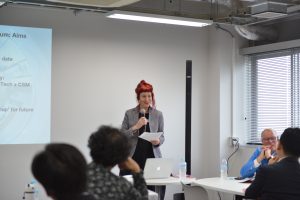
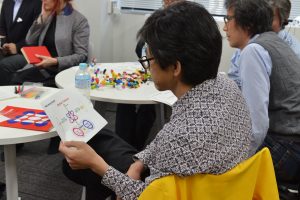
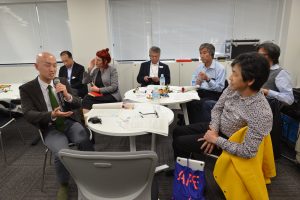
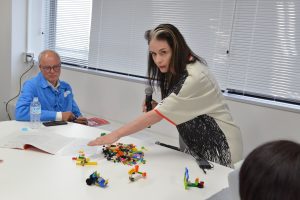
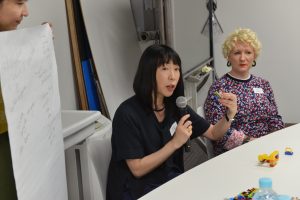
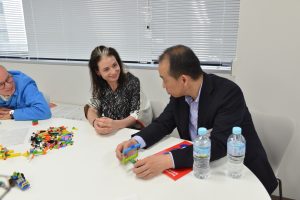
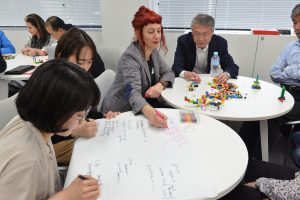
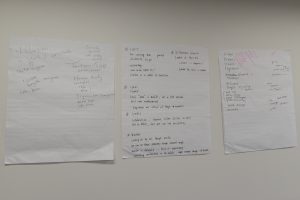
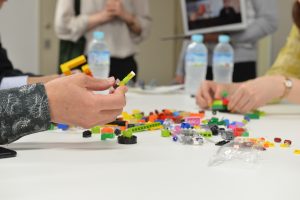
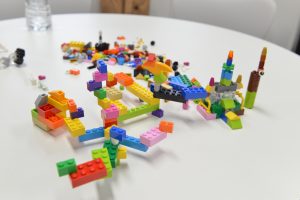
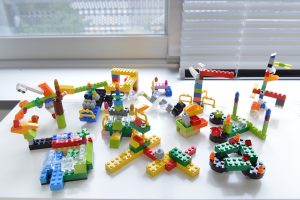
(Photos © Nohara Lab 2019)
5月15日の締結式に先駆け、5月14日にロンドン芸術大学セントラル・セント・マーティンズ校(CSM)とコロキアムが行われました。東工大側からは11名の教員(野原佳代子教授、高田潤一教授、塚本由晴教授、須佐匡裕教授、藤井晴行教授、倉林大輔教授、中山実教授、阿部直也准教授、土方亘准教授、津田広志氏((株)コンセント取締役)、米田晋URA等、一方CSMからは4名(ジェレミー・ティル校長、レイチェル・ディクソン教務部長、ベティ・マレンコWRHI特任教授、ウルリケ・オバーラックWRHI特任教授)が南5号館の会場に集いました。さらにヘザー・バーネット、ネイサン・コーエン博士がロンドンからSkypeを利用して参加しました。2年半にわたるこれまでの連携活動を振り返った共著の白書 “Becoming Hybrid 『生まれゆくハイブリッド(混成)』”の完成と、MOU締結を記念し祝うとともに、レゴを用いて異分野融合の手法と意義について考え、議論がなされました。また野原研の学生たちが通信、運営、ファシリテーション面でサポートをしました。
コロキアムには様々な専門分野からの教員が集い、まず、マレンコ特任教授、オバーラック特任教授と野原教授による、開会の挨拶と過去の活動についての振り返りから始まりました。2017年5月に開催された合同シンポジウム、CSM教員の東工大での研究滞在・講義・哲学カフェ、ウェアラブルワークショップ、一般公開イベント、とロンドンCMSにおいての合同ワークショップ・研修など、過去の一連の活動について、記録映像も流しながら、報告が行われました。科学技術✖︎アート/デザインの「融合」の手法と未来への示唆についての模索、さらにアーツカウンシルから助成金の支援を受け、両大学以外の教育機関や企業からの参加者との交流、様々な思いが詰まった共同活動のロードマップを提示しました。「融合」に関する実験の成果を共有し、「製品化そのもの」を目的としていないことを明確に説明し、「不確定の未来」と対面し、問題提起と打開策を手法となる「融合」と「混成」の意義を共有しました。
続けて、Skypeでロンドンのバーネット先生とつなぎ、バーネット先生のファシリテートで、レゴを用いたワークショップが行われました。会場で両校からの参加者が三つのグループに分けられました。まず一人一人、「このコラボレーションに関する感想、課題と在り方」について抽象的に模型を作り、続いてグループ内でその模型の意味について説明し、最後に、会場内でそれぞれのグループ内の作品と議論について発表し、ロンドンからコーエン博士も自分の模型について説明しディスカッションに加えました。模型がそれぞれ個性的で、「花」、「窓」や「人体」に見立てにしたり、模型そのものの「可変性」・「多様性」・「不確定性」も喩えにしたり、「融合」の計り知れない可能性を、同時通訳も頼りながら、日本語・英語を飛びかわし、ロンドン・東京の間を行き来、議論が膨らみました。とりわけ、建築学の塚本由晴教授の「ネットワーク」をコンセプトとして模型は、違う色のブリックをつなぎ合わせ、大きな構造物となっていた「融合による混成物」を象徴していたように見えます。津田広志氏は、本来つなぎ目ではない部分でブリックをつなげ、従来の見方を問いかけるようなコラボレーションの在り方と、日本の文脈において、近代化によって学問分野が分断される前の「融合」も探るべきだという意見を述べました。
最後の全体討論の中で、参加者が両校の締結後の展望について語りました。機械設計・医工連携(例:人工心臓)を専門とする土方亘教授は、科学技術側からアートとの連携について感想を述べました。科学技術は便利なものですが、アートの方が人を楽しませる力を持っていて、その結合により、幸せへの道へ導かれるではないかと、科学技術✖︎アート/デザインの「融合」の重要な役目を提示しました。
野原研のスタッフと学生もサポートし、参加をしていました。彼らからコロキアムを通しての感想も寄せてきました。博士課程一年・和田千寛氏は、「アートとサイエンスのハイブリッドは、お互いに足りないものを補い合い、新しいものを作り出す可能性に満ちています。サイエンスに不足しがちなもの、例えば「美」や「心」などを、アートは豊富にもっていて、サイエンスとアートのハイブリッドから学ぶことはたくさんある」と述べ、「それぞれだけではどうにも対処できそうにない問題が現れた時、そこで初めてハイブリッドの意味・重要性が生まれる」と修士課程一年・齋藤匠氏が語りました。これからも、「融合」と「ハイブリッド」手法の探求において彼らの熱意の込めた活動を期待しています。
このコロキアムにおいて活発な議論は言語・学問領域・物理的な空間の境界を越え、翌日のMOU締結により共同研究が進めるべく、関係者一同気持ちをあらため、今後さらなる展開と挑戦に向かっています。
(文章:潘 夢斐)